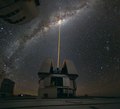Afrikaans: Die ESO-fotoambassadeur Yuri Beletsky het hierdie foto in mid-Augustus 2010 by die
ESO se
Paranal-sterrewag in
Chili bekom. 'n Sterrekundige werkgroep was besig om die
sentrum van die Melkweg te bestudeer met behulp van die lasergidsster-gerief te Yepun, een van die vier eenheidsteleskope van die
Baie Groot Teleskoop (BGT). Yepun se laserstraal oorkruis die suiderhemel om sodoende kunsmatige sterlig 90 kilometer bo die aarde in die mesosfeer te vorm. Die lasergidsster (LGS) is deel van die BGT se aanpassende optiese konfigurasie wat 'n verwysingspunt skep vir korreksie van atmosferiese steuringseffekte op beelde. Die kleur van die laser is gekalibreer om energie oor te dra na 'n laag natriumatome wat in een van die boonste lae van die atmosfeer geleë is, en vermoedelik uit die reste van
meteore bestaan. Die kenmerkende kleur van natriumstraatlampe kan ook aan die laser herken word. Die atome wat deur die laser opgewek word begin te gloei, sodat 'n helder ligpunt gevorm word wat dien as 'n kunsmatige verwysingster vir die
aanpassingsoptiek. Sodoende kan sterrekundiges duideliker waarnemings maak, byvoorbeeld hier waar die sentrum van die
Melkweg onder die loep is. Navorsers kan die galaktiese middelpunt nou beter moniteer, 'n gebied waar 'n
supermassiewe swartkolk gas en stof akkumuleer en sy
gravitasieveld werp oor die naaswentelende sterre. Die beeld is verkry met 'n wyehoeklens wat 'n hoek van sowat 180 grade onderspan.
English: This photo was snapped in mid-August 2010 at ESO’s
Paranal Observatory. A group of astronomers were observing the center of the
Milky Way using the
Laser Guide Star (LGS) facility at Yepun, one of the four Unit Telescopes of the
Very Large Telescope (VLT).
Yepun’s laser beam crosses the majestic southern sky and creates an artificial star at an altitude of 90 km high in the Earth's mesosphere. The Laser Guide Star (LGS) is part of the VLT’s adaptive optics system and is used as a reference to correct the blurring effect of the atmosphere on images. The colour of the laser is precisely tuned to energise a layer of sodium atoms found in one of the upper layers of the atmosphere — one can recognise the familiar colour of sodium street lamps in the colour of the laser. This layer of sodium atoms is thought to be a leftover from meteorites entering the Earth’s atmosphere. When excited by the light from the laser, the atoms start glowing, forming a small bright spot that can be used as an artificial reference star for the adaptive optics. Using this technique, astronomers can obtain sharper observations. For example, when looking towards the centre of our Milky Way, researchers can better monitor the galactic core, where a central supermassive black hole, surrounded by closely orbiting stars, is swallowing gas and dust.
The photo was taken with a wide-angle lens and covers about 180 degrees of the sky.





